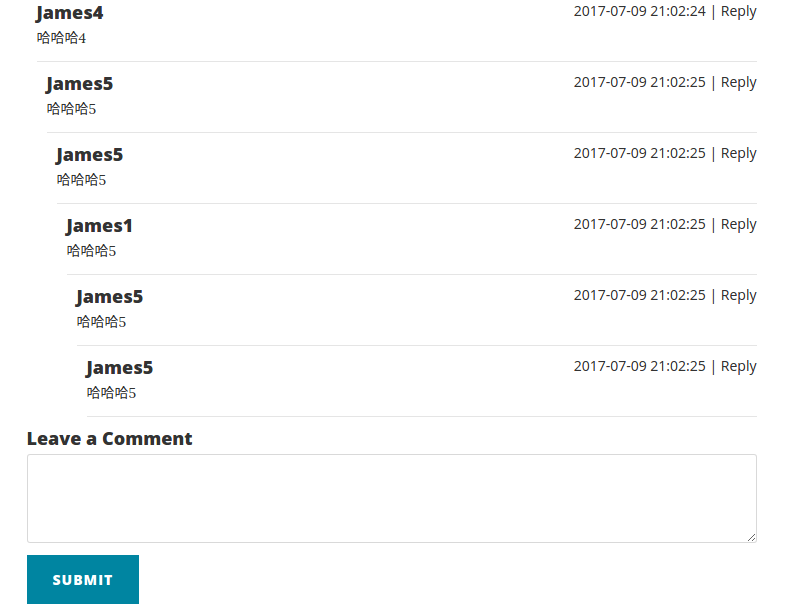前言
我们在一些技术博客中会经常看到很多递归评论,也即是我们可以回复博友的评论,且界面很美观,有梯度的显示格式,日前在空余时间写类似的 demo,所以记录下来,可以给需要的人一些借鉴的作用。
好了,废话少说,直奔主题。。。
思路
我们在写后台程序的时候,经常会遇到生成类似树的这种数据结构,我们直觉就是使用递归的方法来实现,起初我也是这么想的,就是写一个 Angular4 的递归方法,组成一个字符串,然后在界面显示,类似下面代码
@Component({
selector: "comment",
template: '{{ comments }}'
})
export class CommentComponent {
public comments: string = "";
generateComment(Comment comment) {
this.comments = this.comments + "<div>" + comment.content + "</div>";
if (comment.pComment != null) {
generateComment(comment.pComment);
}
}
}
很天真的以为可以了,结果一试,标签不会被解析,才想起已经过了解析标签的过程了。。。
后来想着,现在的前端框架都是以组件化自称, Angular4 也不例外,那么一个 Component 可以嵌入任何 Component,那肯定可以嵌入自己,也就有了类似递归的概念了,想到这立马试试。。。
具体实现
思路是这样子,我定义了数据的格式,是每个评论下面有一个子评论数组,而不是每个评论有一个父评论,数据格式如下:
"comments":
[
{
"id": 1,
"username": "James1",
"time": "2017-07-09 21:02:21",
"content": "哈哈哈1<h1>哈哈哈</h1>",
"status": 1,
"email": "1xxxx@xx.com",
"cComments": [
{
"id": 2,
"username": "James2",
"time": "2017-07-09 21:02:22",
"content": "哈哈哈2",
"status": 1,
"email": "2xxxx@xx.com",
"cComments": null
}
]
}
]
CommentComponent 组件实现了评论模块,但是递归评论并不在这个组件实现,而是在子组件 CommentViewComponent 实现,因为 CommentComponent 还包括一个一个输入评论的文本框。
评论总模块 ComponentComponent 代码:
comment.component.ts
@Component({
selector: 'comment',
templateUrl: './comment.component.html',
styleUrls: ['./comment.component.css']
})
export class CommentComponent implements OnInit {
@Input()
public comments: Comment[];
ngOnInit(): void {
}
}
comment.component.html
<div class="container font-small">
<div class="row">
<div class="col-lg-8 offset-lg-2 col-md-10 offset-md-1">
<comment-view [comments]="comments"></comment-view>
<div class="well" id="comment">
<h4>{{ 'comment.leaveComment' | translate }}</h4>
<form role="form">
<div class="form-group">
<input type="hidden" [(ngModel)]="id" name="id">
<textarea [(ngModel)]="content" name="content" class="form-control" rows="5"></textarea>
</div>
<button type="submit" class="btn btn-primary">Submit</button>
</form>
</div>
</div>
</div>
</div>
comment.component.css
.media {
font-size: 14px;
}
.media-object {
padding-left: 10px;
}
子模块 ComponentViewComponent 代码:
component-view.component.ts
@Component({
selector: 'comment-view',
templateUrl: './comment-view.component.html',
styleUrls: ['./comment-view.component.css']
})
export class CommentViewComponent implements OnInit {
@Input()
public comments: Comment[];
constructor(private router: Router,
private activateRoute: ActivatedRoute ) {
}
ngOnInit(): void {
}
}
component-view.component.html
<div *ngFor="let comment of comments">
<div class="media">
<div class="pull-left">
<span class="media-object"></span>
</div>
<div class="media-body">
<h4 class="media-heading">{{ comment.username }}
<small class="pull-right">{{ comment.time }} | <a href="#" rel="external nofollow" >{{ 'comment.reply' | translate }}</a></small>
</h4>
{{ comment.content }}
<hr>
<comment-view *ngIf="comment.cComments != null" [comments]="comment.cComments"></comment-view>
</div>
</div>
</div>
comonent-view.component.css
.media {
font-size: 14px;
}
.media-object {
padding-left: 10px;
}
结果
这时的展示结果如下图所示:

上面只是说明了如何实现评论梯形显示,在博客评论中我们经常看到可以回复某一条评论,本文讲述如何实现点击某一条评论的回复按钮后,获取该条评论的内容并显示在输入框中。类似 CSDN 博客评论一样,点击回复后输入框自动添加了 [reply]u011642663[/reply]
思路
依据上一篇文章中的评论梯形显示,我们还需要实现点击回复后,屏幕自动到达输入框位置,并且获取了点击回复的评论的信息。首先分解一下这个功能点,在项目中我们也会经常分解功能点,这个功能点有 2 个小点:一是在每条评论中加上 [回复] 按钮,点击回复后跳到输入框位置;二是点击回复后,获取到点击回复的那条评论的信息。下面我们一一解决。
跳转到输入框
我们接触前段第一个语言便是 HTML,我们知道 HTML 中有一个 # 定位,下面代码简单解释一下。
假设这个 HTML 代码文件是 index.html
<html> <head> </head> <body> <a href="index.html#pointer" rel="external nofollow" >Click me to pointer</a> <div id="pointer"> <h1>哈哈哈哈</h1> </div> </body> </html>
上面代码只要点击 Click me to pointer 这个链接,页面就会跳到 id=”pointer” 这个 div 的位置。所以我们在实现这个点击回复跳转到输入框中就可以使用这个方法。
我们在 comment-component.html 中将评论输入框加入 id=”comment”,接下来就是路径拼接的问题了,我们可以通过 Angular 的 Router 的 url 来获取本页面的路径,然后在这个路径后面加入 #comment 就可以实现跳转了,下面是实现这个跳转功能的代码
添加 id=”comment”
comment-component.html
<!-- Comment -->
<div class="container font-small">
<div class="row">
<div class="col-lg-8 offset-lg-2 col-md-10 offset-md-1">
<comment-view [comments]="comments" (contentEvent)="getReplyComment($event)" ></comment-view>
<div class="well" id="comment">
<h4>{{ 'comment.leaveComment' | translate }}</h4>
<form role="form">
<div class="form-group">
<input type="hidden" [(ngModel)]="id" name="id">
<textarea [(ngModel)]="content" name="content" class="form-control" rows="5"></textarea>
</div>
<button type="submit" class="btn btn-primary">Submit</button>
</form>
</div>
</div>
</div>
</div>
添加通过路由获取当前页面 URL
comment-view.component.ts
@Component({
selector: 'comment-view',
templateUrl: './comment-view.component.html',
styleUrls: ['./comment-view.component.css']
})
export class CommentViewComponent implements OnInit {
@Input()
public comments: Comment[];
// 用于跳转到回复输入框的url拼接
public url: string = "";
constructor(private router: Router,
private activateRoute: ActivatedRoute ) {
}
ngOnInit(): void {
this.url = this.router.url;
this.url = this.url.split("#")[0];
this.url = this.url + "#comment";
}
}
添加链接 href=”“
comment-view.component.html
<div *ngFor="let comment of comments">
<div class="media">
<div class="pull-left">
<span class="media-object"></span>
</div>
<div class="media-body">
<h4 class="media-heading">{{ comment.username }}
<small class="pull-right">{{ comment.time }} | <a href="{{url}}" rel="external nofollow" rel="external nofollow" (click)="reply(comment)" >{{ 'comment.reply' | translate }}</a></small>
</h4>
{{ comment.content }}
<hr>
<comment-view *ngIf="comment.cComments != null" [comments]="comment.cComments" (contentEvent)="transferToParent($event)"></comment-view>
</div>
</div>
</div>
这就实现了页面跳转的功能点,接下来实现获取回复的评论的信息。
获取回复的评论信息
有人会说获取回复的评论信息,这不简单么?加个 click 事件不就行了。还记得上一篇文章咱们是如何实现梯形展示评论的么?咱们是通过递归来实现的,怎么添加 click 事件让一个不知道嵌了多少层的组件能够把评论信息传给父组件?首先不具体想怎么实现,我们这个思路是不是对的:把子组件的信息传给父组件?答案是肯定的,我们就是要把不管嵌了多少层的子组件的信息传给 comment.component.ts 这个评论模块的主组件。
Angular 提供了 @Output 来实现子组件向父组件传递信息,我们在 comment-view.component.ts 模块中添加 @Output 向每个调用它的父组件传信息,我们是嵌套的,这样一层一层传出来,直到传给 comment-component.ts 组件。我们看代码怎么实现。
实现代码
comment-view.component.ts
@Component({
selector: 'comment-view',
templateUrl: './comment-view.component.html',
styleUrls: ['./comment-view.component.css']
})
export class CommentViewComponent implements OnInit {
@Input()
public comments: Comment[];
// 点击回复时返回数据
@Output()
public contentEvent: EventEmitter<Comment> = new EventEmitter<Comment>();
// 用于跳转到回复输入框的url拼接
public url: string = "";
constructor(private router: Router,
private activateRoute: ActivatedRoute ) {
}
ngOnInit(): void {
this.url = this.router.url;
this.url = this.url.split("#")[0];
this.url = this.url + "#comment";
}
reply(comment: Comment) {
this.contentEvent.emit(comment);
}
transferToParent(event) {
this.contentEvent.emit(event);
}
}
comment-view.component.html
<div *ngFor="let comment of comments">
<div class="media">
<div class="pull-left">
<span class="media-object"></span>
</div>
<div class="media-body">
<h4 class="media-heading">{{ comment.username }}
<small class="pull-right">{{ comment.time }} | <a href="{{url}}" rel="external nofollow" rel="external nofollow" (click)="reply(comment)" >{{ 'comment.reply' | translate }}</a></small>
</h4>
{{ comment.content }}
<hr>
<comment-view *ngIf="comment.cComments != null" [comments]="comment.cComments" (contentEvent)="transferToParent($event)"></comment-view>
</div>
</div>
</div>
comment.component.ts
@Component({
selector: 'comment',
templateUrl: './comment.component.html',
styleUrls: ['./comment.component.css']
})
export class CommentComponent implements OnInit {
@Input()
public comments: Comment[];
// 要回复的评论
public replyComment: Comment = new Comment();
public id: number = 0;
public content: string = "";
ngOnInit(): void {
}
getReplyComment(event) {
this.replyComment = event;
this.id = this.replyComment.id;
this.content = "[reply]" + this.replyComment.username + "[reply]\n";
}
}
comment.component.html
<!-- Comment -->
<div class="container font-small">
<div class="row">
<div class="col-lg-8 offset-lg-2 col-md-10 offset-md-1">
<comment-view [comments]="comments" (contentEvent)="getReplyComment($event)" ></comment-view>
<div class="well" id="comment">
<h4>{{ 'comment.leaveComment' | translate }}</h4>
<form role="form">
<div class="form-group">
<input type="hidden" [(ngModel)]="id" name="id">
<textarea [(ngModel)]="content" name="content" class="form-control" rows="5"></textarea>
</div>
<button type="submit" class="btn btn-primary">Submit</button>
</form>
</div>
</div>
</div>
</div>
解释一下代码逻辑:
我们在 comment-view.component.ts 添加以下几点:
在 comment.component.ts 中定义了 getReplyComment(event) 方法,该方法接收子组件传递来的评论信息,并将信息显示在页面上。大功告成。。。
效果图

总结
以上就是这篇文章的全部内容了,希望本文的内容对大家的学习或者工作具有一定的参考学习价值,如果有疑问大家可以留言交流,谢谢大家对的支持。